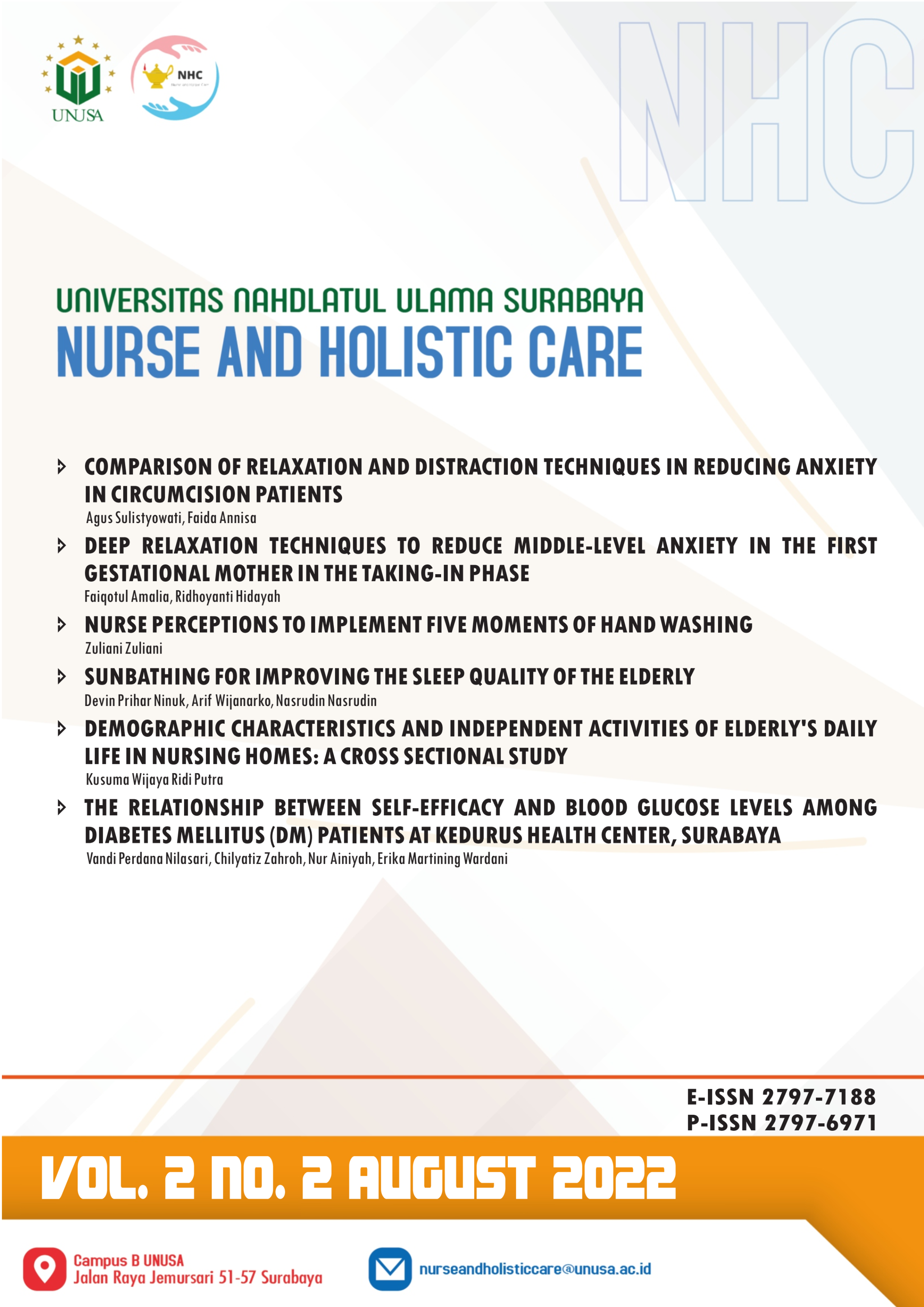COMPARISON OF RELAXATION AND DISTRACTION TECHNIQUES IN REDUCING ANXIETY IN CIRCUMCISION PATIENTS
##plugins.themes.bootstrap3.article.main##
Abstract
Background: Relaxation and distraction are nonpharmacologic techniques in the therapy of anxiety. In circumcision patients, the experience of anxiety is felt by the patients, either children or adolescent.
Objective: The study aimed to compare between relaxation and distraction technique in reducing anxiety in circumcision patients.
Methods: The study design was a pre-experimental two-group pretest-posttest research design. Total 36 respondents on this study that divided equal to two group (relaxation group and distraction group). The respondents have been assessed their anxiety level before and after the intervention (pre-test and post-test for each group). The instrument of anxiety was Hamilton Rating Scale for Anxiety (HARS). The statistics test used Wilcoxon Signed-Rank Test.
Results: The Wilcoxon Signed rank test results for relaxation group was in a Z statistic of -3.317 which results in an exact p value of .001; and the results for distraction group was in a Z statistic of -2.449 which results in an exact p value of .014.
Conclusion: There was different result between relaxation and distraction group that showed relaxation group reducing anxiety in higher score of a Z statistic compared with distraction group. However, those technique were effectively in decreasing the anxiety level of circumcision patients.
Downloads
##plugins.themes.bootstrap3.article.details##
Copyright (c) 2022 Agus Sulistyowati, Faida Annisa

This work is licensed under a Creative Commons Attribution-NonCommercial 4.0 International License.
Authors who publish with Nurse and Holistic Care agree to the following terms:
- Authors retain copyright licensed under a Creative Commons Attribution-NonCommercial 4.0 (CC BY-NC 4.0), which allows others to remix, tweak, and build upon the authors' work non-commercially, and although the others' new works must also acknowledge the authors and be non-commercial, they don't have to license their derivative works on the same terms.
- Authors are permitted and encouraged to post their work online (e.g., in institutional repositories or on their website) prior to and during the submission process, as it can lead to productive exchanges, as well as earlier and greater citation of published work (See The Effect of Open Access). Authors can archive pre-print and post-print or publisher's version/PDF.
References
Bicer, S., Kuyrukluyildiz, U., Akyol, F., Sahin, M., Binici, O., & Onk, D. (2015). At What Age Range Should Children Be Circumcised? Iranian Red Crescent Medical Journal, 17(3). https://doi.org/ 10.5812/ircmj.26258. DOI: https://doi.org/10.5812/ircmj.26258
Darlina. (2006). Perbandingan Teknik Relaksasi Bernafas Terhadap Intensitas Nyeri. Universitas Pembangunan Veteran Medan.
Dio, Eko Widakdo. (2017). Perbandingan Teknik Distraksi Visual Film Kartun Terhadap Ansietas Anak Pre Operasi Sirkumsisi Di Tempat Praktek Mandiri Perawat Js Ngawi. Thesis STIKES Bhakti Husada Mulia.
Potter & Perry. (2010). Fundamental of Nursing edisi 7. Jakarta: Salemba medika.
Prasetyono, Teddy. (2009). Panduan Sirkumsisi Tanpa Nyeri Pada Anak Sebuah Paradigma Baru. Medya Crea, Jakarta.
Ramaiah. (2003). Kecemasan: Bagaimana Mengatasi Penyebabnya. Jakarta: Pustaka Obor.
Stuart, Gail. (2013). Principles and Practice of Psychiatric Nursing. USA: Elsevier Molby.
Sumiati, Kadrianti & Basri. (2013). Perbandingan Penggunaan Teknik Relaksasi Nafas Dalam, Distraksi, GateKotrol, terhadap Penurunan Sensasi Nyeri Ca Mammae Di RSUD Labuang Baji Makasar. Jurnal Keperawatan.
Smeltzer, Suzanne C. dan Brenda G. Bare. (2001). Buku Ajar Keperawatan Medikal-Bedah, Edisi 8., Jakarta: EGC.
Syamsir, H. M. (2014). Sirkumsisi Berbasis Kompetensi (Ed. 2). Jakarta: EGC, 2014.
Wibrata DA, Putri RNA, Annisa F, et al. (2019). The Effect of Breathing Exercises: Pursed-Lips Breathing and Diaphragm Breathing in COPD Patients. In: International Conference of Kerta Cendekia Nursing Academy. Sidoarjo: Kerta Cendekia Nursing Academy, 2019, pp. 8–11.

